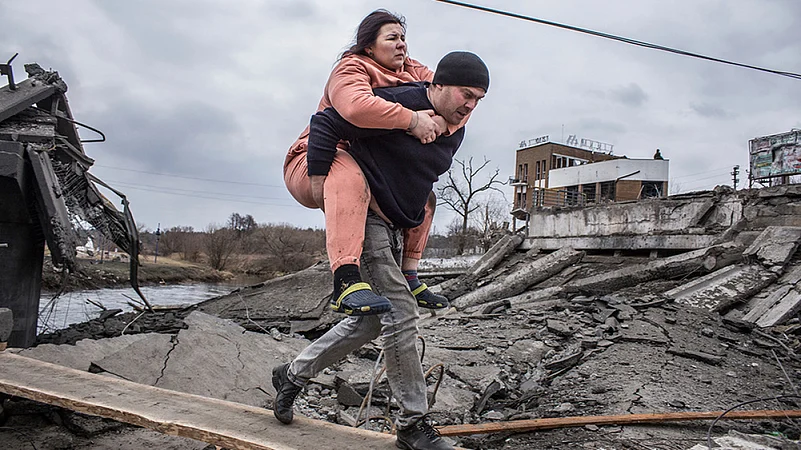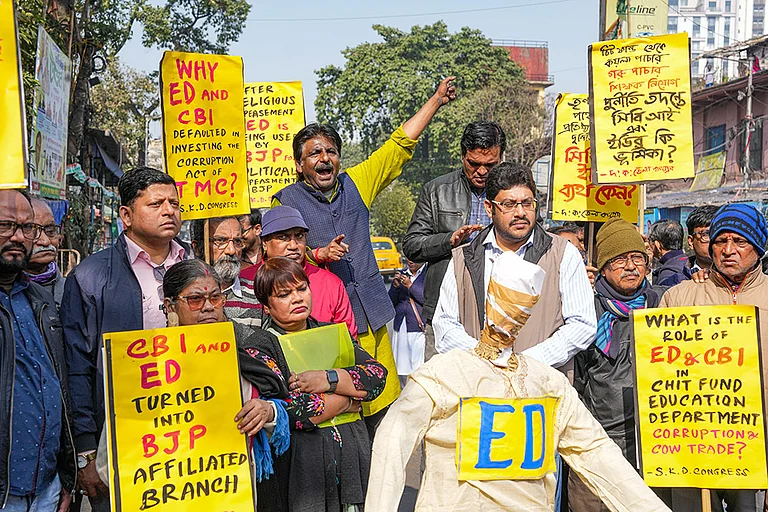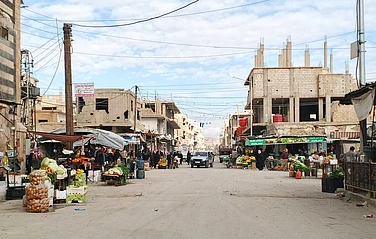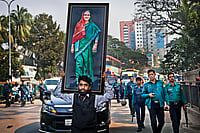"The war will end. The leaders will shake hands. The old woman will keep waiting for her martyred son. That girl will wait for her beloved husband. And those children will wait for their heroic father. I don’t know who sold our homeland. But I saw who paid the price."
These are the words of the late Palestinian poet Mahmoud Darwish, who saw death and destruction in his homeland. Darwish was writing not just about Palestine but the cost of war waged anywhere in the world. It could be anywhere in the jungles of Africa or urban warfare in Iraq, Syria or Europe, the result is invariably the same: Ordinary civilians bear the brunt for the folly and ambition of leaders.
Yesterday it was Afghanistan and today it is Ukraine. And the war in Yemen continues, it has done so for seven years. Yemen is just a blip in our consciousness because it is not flashing on our television screens every day. Last August, during the disastrous pull-out of the US forces from Afghanistan, images of desperate Afghans rushing to the airport to escape to freedom kept us riveted to the screen. Horrific sights of people hanging on to the wings of an American military plane and falling to death brought home the reality of war. Yet a few months down the line, Russia’s military action in Ukraine is leading to the same mad rush out of the country.
The United Nations High Commission for Refugees (UNHCR) said a week back, "The current total is now 368,000 and continues to rise," the UN figures are based on "data made available by national authorities". By the end of the week, these figures will swell if the war continues. The UN estimates there could be about four million Ukrainian refugees if fighting continues. The latest figure from the UN is 1.2 million Ukrainians have left the country.
President Volodymyr Zelenskyy’s government is not allowing able-bodied men between the ages of 18-60 to leave the country, needing them to bolster the national army numbers. A civilian volunteer force is being provided with weapons to fight the Russian army if needed. Arms have been flowing into Ukraine from the US and NATO allies since 2014. This was stepped up as tensions flared ahead of the current crisis. Small arms are also available in plenty. These are being distributed to civilians to defend the homeland.
Somehow countries never look back at history. Much of the problems in the border area between Pakistan and Afghanistan from where terror groups operate, is because arms are plentiful in the area. The US had provided to the mujahideen groups fighting the former Soviet army at the request of the then president Najibullah. The area was awash with arms, including stinger missiles. Flowing in arms to arm a volunteer army may solve the immediate problem but letting weapons out to the public could later have disastrous consequences. For now, Ukraine is being applauded for arming able-bodied citizens.
As the men have to stay back in Ukraine, they are sending out their families to safety across the international border to Poland, to Rumania and Hungary. There is a mad scramble at the crossing points here. Lines of cars and people waiting to cross over stretch sometimes into 20 km long queues on the Polish border. Besides the refugees fleeing the fighting, there are seven million internally displaced people rushing out of eastern and southeastern Ukrainian cities and towns.
In Kharkiv the second largest city in Ukraine, just 25 miles from Russia, a ding-dong battle is on between for control of the city. At times the city appears to be in control of Russia but swings back to Ukraine fighting is continuing playgrounds and apartment buildings have been hit. Civilians in the war zone are hunkering in war shelters, running out of food, water and essentials. "The conflict in Ukraine is a devastating blow for millions of Ukrainians who have already been living in a humanitarian crisis even before the first bombs fell. At this point, there is no way to ease the suffering that is to come unless there is a total stop to the conflict. Short of that, millions of people may suffer as the country spirals into a humanitarian crisis that impacts Ukraine's most vulnerable people,’’ Chris Skopec, Executive Vice President of Global Health for Project HOPE, who has been working for people in conflict areas, said.
The plight of Indians, mostly students stuck in the conflict zones like Kharkiv and Sumy is a matter of major concern to their families back home. India has launched Operation Ganga to evacuate Indian nationals. The problem is with the airspace over Ukraine closed, everyone needs to get out through the land borders to cross over to safety and a ride back home on evacuation flights. While as many as 17,000 of around 20,000 Indians in Ukraine are out, Sumy remains a major issue. Students from Kharkiv have mostly escaped according to the MEA, the concentration is on 700 to 800 medical students stuck in Sumy. All efforts are being made by the embassy to arrange for buses and bring them through a humanitarian corridor. As of now, efforts are still on.
There are disturbing reports of the Ukrainian army’s treatment of Indian students. Perhaps angry with the Indian government’s stand at the United Nations Security Council, where Delhi has abstained from condemning Russian action, Ukrainian soldiers at the check points have harassed Indians and beat up several of them. The same kind of treatment is being meted out to African and other non-Western(read non-White) foreigners trying to leave the country. Videos sent out by several hapless Indian students recount their horrific experiences at the hands of the Ukrainian army. BBC reported that there were "too many testimonies to discount now of Blacks and Indians mistreated and prevented from leaving by Ukrainian officials.’’
Europe as a rule dislikes refugees. During the Syrian conflict cities were flooded with people fleeing the war at home. Germany was the most generous, while France, Netherlands, Switzerland and Greece took in many of them. However, the majority of the public were resentful of the presence of Syrians. Many Afghans that managed to escape during the US airlift from Kabul are languishing in make shift camps as they await permission to get re settled. Europe does not want them.
However, Ukrainians are being warmly welcomed. The EU has announced that it will ask member states to grant temporary asylum for up to three years to Ukrainian nationals. Romanians are coming to the border check points to pick up Ukrainian families and open their homes to them. Several European countries have announced that travel on trains and buses would be free for Ukrainians fleeing the war.
Poland and Hungary are two countries that have been hostile to migrants whether from Syria or Afghanistan have welcomed the latest wave of refugees, saying they are Christians, are White and very similar to us.



























